Reiner S. Thomä
Modeling Micro-Doppler Signature of Multi-Propeller Drones in Distributed ISAC
Apr 07, 2025Abstract:Integrated Sensing and Communication (ISAC) will be one key feature of future 6G networks, enabling simultaneous communication and radar sensing. The radar sensing geometry of ISAC will be multistatic since that corresponds to the common distributed structure of a mobile communication network. Within this framework, micro-Doppler analysis plays a vital role in classifying targets based on their micromotions, such as rotating propellers, vibration, or moving limbs. However, research on bistatic micro-Doppler effects, particularly in ISAC systems utilizing OFDM waveforms, remains limited. Existing methods, including electromagnetic simulations often lack scalability for generating the large datasets required to train machine learning algorithms. To address this gap, this work introduces an OFDM-based bistatic micro-Doppler model for multi-propeller drones. The proposed model adapts the classic thin-wire model to include bistatic sensing configuration with an OFDM-like signal. Then, it extends further by incorporating multiple propellers and integrating the reflectivity of the drone's static parts. Measurements were performed to collect ground truth data for verification of the proposed model. Validation results show that the model generates micro-Doppler signatures closely resembling those obtained from measurements, demonstrating its potential as a tool for data generation. In addition, it offers a comprehensive approach to analyzing bistatic micro-Doppler effects.
Bistatic Micro-Doppler Analysis of a Vertical Takeoff and Landing (VTOL) Drone in ICAS Framework
Feb 12, 2025Abstract:Integrated Communication and Sensing (ICAS) is a key technology that enables sensing functionalities within the next-generation mobile communication (6G). Joint design and optimization of both functionalities could allow coexistence, therefore it advances toward joint signal processing and using the same hardware platform and common spectrum. Contributing to ICAS sensing, this paper presents the measurement and analysis of the micro-Doppler signature of Vertical Takeoff and Landing (VTOL) drones. Measurement is performed with an OFDM-like communication signal and bistatic constellation, which is a typical case in ICAS scenarios. This work shows that micro-Doppler signatures can be used to precisely distinguish flight modes, such as take-off, landing, hovering, transition, and cruising.
BIRA: A Spherical Bistatic Reflectivity Measurement System
Jul 18, 2024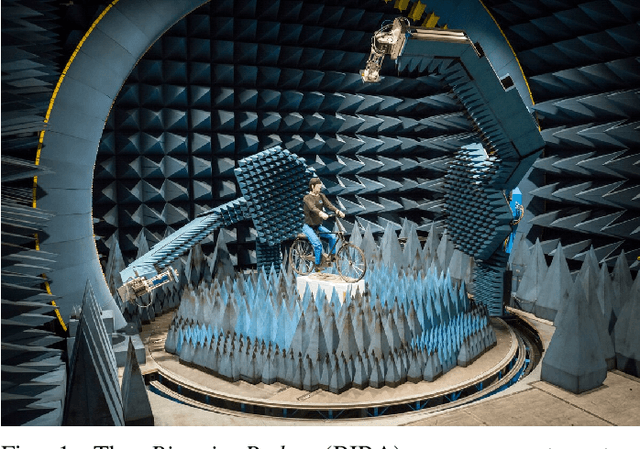
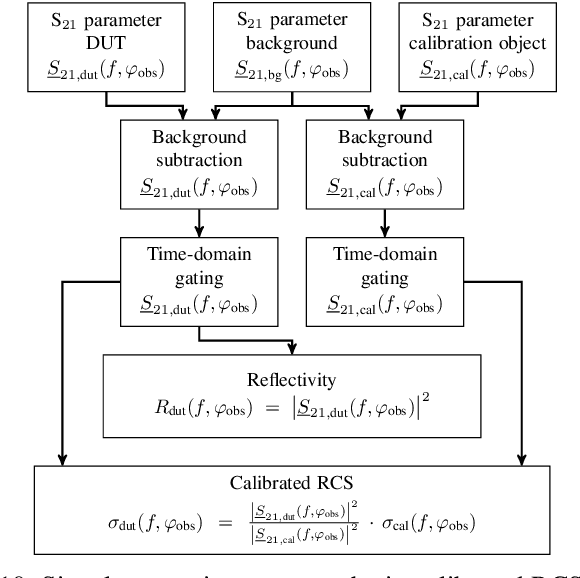
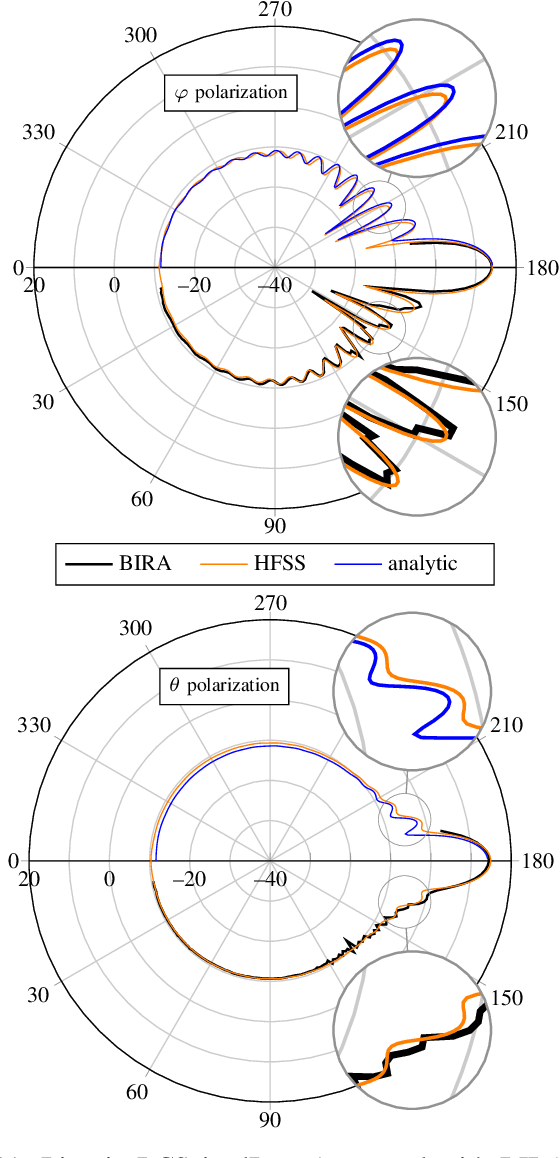
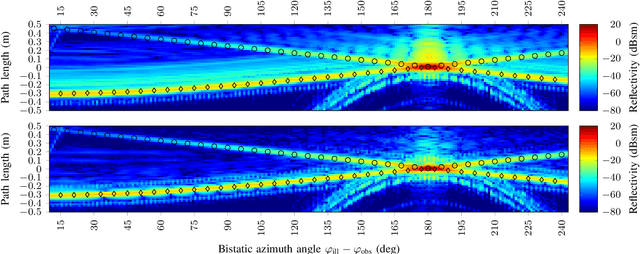
Abstract:The upcoming 6G mobile communication standard will offer a revolutionary new feature: Integrated sensing and communication (ISAC) reuses mobile communication signals to realize multi-static radar for various applications including localization. Consequently, applied ISAC propagation research necessitates to evolve from classical monostatic radar cross section (RCS) measurement of static targets on to bistatic radar reflectivity characterization of dynamic objects. Here, we introduce our "Bistatic Radar" (BIRA) and antenna measurement facility for bistatic spherical positioning with sub-millimeter accuracy on a diameter of up to 7 m and with almost continuous frequency coverage from 0.7 up to 260 GHz. Currently, BIRA is the only bistatic measurement facility capable of unrestricted ISAC research: In addition to vector network analysis, BIRA employs advanced wideband transceiver technology with an instantaneous bandwidth of up to 4 GHz. These transceivers grant BIRA the unique ability to characterize dynamic targets in both Doppler and range, while also significantly accelerating RCS measurements of static objects.
Transfer Learning for CSI-based Positioning with Multi-environment Meta-learning
May 20, 2024



Abstract:Utilizing deep learning (DL) techniques for radio-based positioning of user equipment (UE) through channel state information (CSI) fingerprints has demonstrated significant potential. DL models can extract complex characteristics from the CSI fingerprints of a particular environment and accurately predict the position of a UE. Nonetheless, the effectiveness of the DL model trained on CSI fingerprints is highly dependent on the particular training environment, limiting the trained model's applicability across different environments. This paper proposes a novel DL model structure consisting of two parts, where the first part aims at identifying features that are independent from any specific environment, while the second part combines those features in an environment specific way with the goal of positioning. To train such a two-part model, we propose the multi-environment meta-learning (MEML) approach for the first part to facilitate training across various environments, while the second part of the model is trained solely on data from a specific environment. Our findings indicate that employing the MEML approach for initializing the weights of the DL model for a new unseen environment significantly boosts the accuracy of UE positioning in the new target environment as well the reliability of its uncertainty estimation. This method outperforms traditional transfer learning methods, whether direct transfer learning (DTL) between environments or completely training from scratch with data from a new environment. The proposed approach is verified with real measurements for both line-of-sight (LOS) and non-LOS (NLOS) environments.
Deep Learning based Positioning with Multi-task Learning and Uncertainty-based Fusion
Mar 13, 2024



Abstract:Deep learning (DL) methods have been shown to improve the performance of several use cases for the fifth-generation (5G) New radio (NR) air interface. In this paper we investigate user equipment (UE) positioning using the channel state information (CSI) fingerprints between a UE and multiple base stations (BSs). In such a setup, a single DL model can be trained for UE positioning using the CSI fingerprints of the multiple BSs as input. Alternatively, based on the CSI at each BS, a separate DL model can be trained at each BS and then the output of the different models are combined to determine the UE's position. In this work we compare these different fusion techniques and show that fusing the output of separate models achieves higher positioning accuracy, especially in a dynamic scenario. We also show that the fusion of multiple outputs further benefits from considering the uncertainty of the output of the DL model at each BS. For a more efficient training of the DL model across BSs, we additionally propose a multi-task learning (MTL) scheme by sharing some parameters across the models while jointly training all models. This method, not only improves the accuracy of the individual models, but also of the final combined estimate. Lastly, we evaluate the reliability of the uncertainty estimation to ascertain which of the fusion methods provides the highest quality of uncertainty estimates.
Sounding-Based Evaluation of Multi-Sensor ISAC Networks for Drone Applications: Measurement and Simulation Perspectives
Feb 26, 2024



Abstract:With the upcoming multitude of commercial and public applications envisioned in the mobile 6G radio landscape using unmanned aerial vehicles (UAVs), integrated sensing and communication (ISAC) plays a key role to enable the detection and localization of passive objects with radar sensing, while optimizing the utilization of scarce resources. To explore the potential of future ISAC architectures with UAVs as mobile nodes in distributed multi-sensor networks, the system's fundamental capability to detect static and dynamic objects that reveal themselves by their bi-static back-scattering needs to be evaluated. Therefore, this paper addresses simulation- and measurement based data acquisition methods to gather knowledge about the bistatic reflectivity of single objects including their Micro-Doppler signature for object identification as well as the influence of multipath propagation in different environments on the localization accuracy and radar tracking performance. We show exemplary results from simulation models, bi-static reflectivity measurements in laboratory environment and real-flight channel sounding experiments in selected scenarios showcasing the potential of synthetic and measured data sets for development and evaluation of ISAC algorithms. The presented measurement data sets are publicly available to encourage the academic RF community to validate future algorithms using realistic scenarios alongside simulations models.
Modelling Micro-Doppler Signature of Drone Propellers in Distributed ISAC
Jan 25, 2024



Abstract:Integrated Sensing and Communication (ISAC) comprises detection and analysis of non-cooperative targets by exploiting the resources of the mobile radio system. In this context, micro-Doppler is of great importance for target classification, in order to distinguish objects with local movements. For developing algorithms for target classification, it is necessary to have a large amount of target signatures. Aiming to generate these data, this paper proposes a mathematical model for the micro-Doppler of drone rotating propellers, and validate the proposed model by comparing it to measured micro-Doppler. Results show that the proposed mathematical model can generate micro-Doppler data very similar to those from measurement data.
Static Reflectivity and Micro-Doppler Signature of Drones for Distributed ICAS
Jan 25, 2024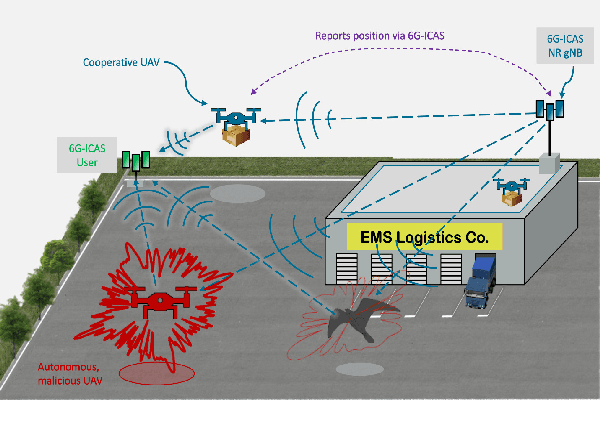
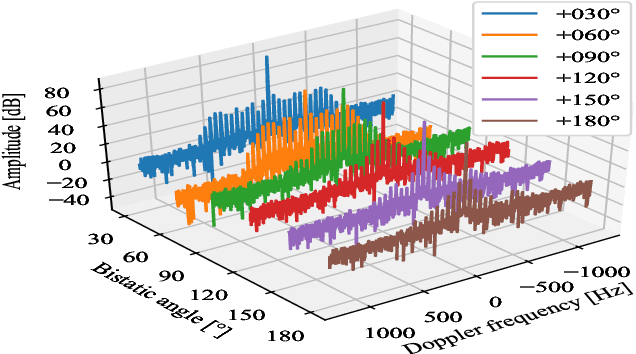
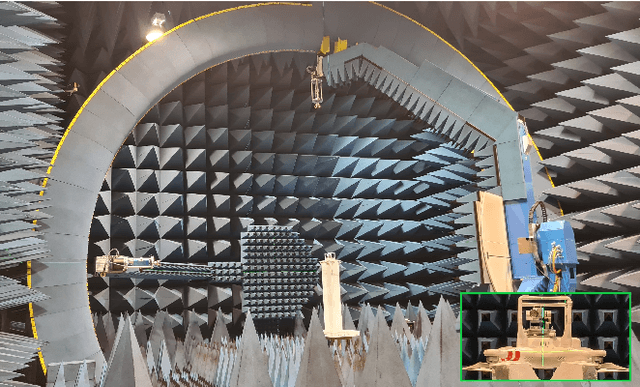
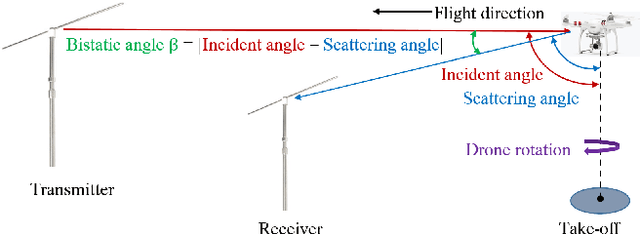
Abstract:The integration of wireless communication and radar sensing is now getting a huge interest from researchers of two big societies, wireless communication and radar. The road map to the final goal and individual solutions to the challenges might differ in developing the Integrated Communication and Sensing (ICAS) system. However, the electromagnetic signature of the targets will be still valid for all variants of the ICAS system because the detection, localization and classification of the targets are involved. Therefore, this paper presents a study on static reflectivity and micro-Doppler signatures of drones together. To acquire the required data, the state-of-the-art measurement system, BiRa, is used.
Multi-Environment based Meta-Learning with CSI Fingerprints for Radio Based Positioning
Oct 26, 2022Abstract:Radio based positioning of a user equipment (UE) based on deep learning (DL) methods using channel state information (CSI) fingerprints have shown promising results. DL models are able to capture complex properties embedded in the CSI about a particular environment and map UE's CSI to the UE's position. However, the CSI fingerprints and the DL models trained on such fingerprints are highly dependent on a particular propagation environment, which generally limits the transfer of knowledge of the DL models from one environment to another. In this paper, we propose a DL model consisting of two parts: the first part aims to learn environment independent features while the second part combines those features depending on the particular environment. To improve transfer learning, we propose a meta learning scheme for training the first part over multiple environments. We show that for positioning in a new environment, initializing a DL model with the meta learned environment independent function achieves higher UE positioning accuracy compared to regular transfer learning from one environment to the new environment, or compared to training the DL model from scratch with only fingerprints from the new environment. Our proposed scheme is able to create an environment independent function which can embed knowledge from multiple environments and more effectively learn from a new environment.
Reliable Deep Learning based Localization with CSI Fingerprints and Multiple Base Stations
Nov 23, 2021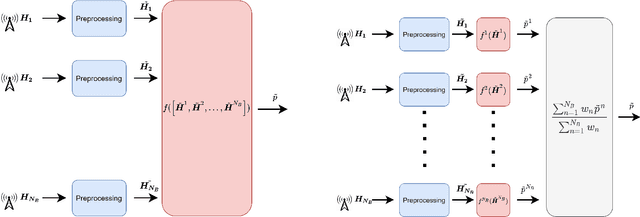
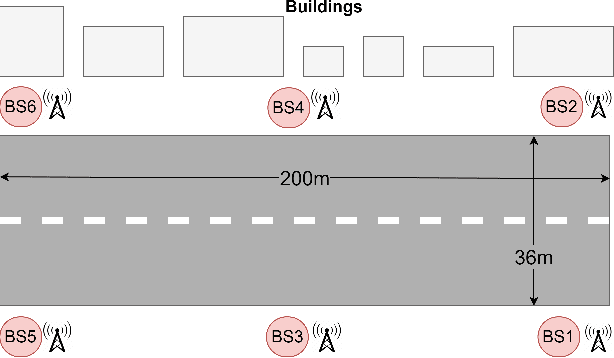


Abstract:Deep learning (DL) methods have been recently proposed for user equipment (UE) localization in wireless communication networks, based on the channel state information (CSI) between a UE and each base station (BS) in the uplink. With the CSI from the available BSs, UE localization can be performed in different ways. One the one hand, a single neural network (NN) can be trained for the UE localization by considering the CSI from all the available BSs as one overall fingerprint of the user's location. On the other hand, the CSI at each BS can be used to obtain an estimate of the UE's position with a separate NN at each BS, and then the position estimates of all BSs are combined to obtain an overall estimate of the UE position. In this work, we show that UE localization with the latter approach can achieve a higher positioning accuracy. We propose to consider the uncertainty in the UE localization at each BS, such that overall UE's position is determined by combining the position estimates of the different BSs based on the uncertainty at each BS. With this approach, a more reliable position estimate can be obtained in case of variations in the channel.
 Add to Chrome
Add to Chrome Add to Firefox
Add to Firefox Add to Edge
Add to Edge